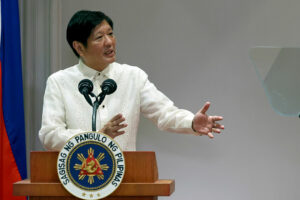Economy can still handle more rate hikes, say analysts

THE PHILIPPINE ECONOMY will likely be able to handle further monetary tightening by the Bangko Sentral ng Pilipinas (BSP) as domestic demand remains resilient, analysts said.
This as BSP Governor Eli M. Remolona signaled the possibility of further monetary tightening, adding that it is “premature” to discuss rate cuts as inflation is still beyond the 2-4% target band.
“We want to be well into the target range first before we consider anything like a rate cut. It could depend on how weak the economy is, or how strong the economy is. But we will see,” Mr. Remolona said in an interview with Bloomberg Television’s Kathleen Hays in Toronto aired on Monday.
Inflation eased to a 14-month low of 5.4% in June. However, this still exceeded the BSP’s 2-4% target range for the 15th consecutive month.
For the first six months of the year, headline inflation stood at 7.2%, still above the central bank’s 5.4% full-year forecast.
“If our tightening has worked, it might have worked more effectively than we thought, then we have to wonder if there’s a risk of recession. Then we might consider a rate cut,” Mr. Remolona said.
Last month, the BSP kept its benchmark interest rate unchanged for a second meeting at 6.25%. The Monetary Board has raised borrowing costs by 425 basis points (bps) from May 2022 to March 2023.
China Banking Corp. Chief Economist Domini S. Velasquez said the Philippine economy will be able to withstand the nearly 16-year-high borrowing costs.
“We are confident that the Philippines will not fall into a recession (two quarters of negative GDP growth rates) due to resilient domestic demand,” she said in a Viber message. “Consumption remains robust despite high inflation. Now that inflation is on a downtrend, we expect further support for domestic consumption.”
In the first quarter, the Philippine economy grew by 6.4%, the slowest in two years amid rising interest rates and elevated inflation. The government expects the economy to grow by 6-7% this year.
Ms. Velasquez noted that BSP Deputy Governor Francisco G. Dakila, Jr. had previously said that a 25-bp policy rate adjustment may only impact gross domestic product (GDP) by just 2 bps.
“If we look at previous years, the real interest rate (policy rate minus inflation) in 2016 was quite high, but the country managed to post a GDP of 7.1%,” she added.
‘TIGHTENING SIDE’Mr. Remolona said the BSP remains “more on the tightening” side amid upside risks to inflation.
“We’re worried about the El Niño, we’re worried about the minimum wages being raised,” he said. “For now, we’re contemplating whether to hike or not to hike. We’re not thinking about whether to cut or not to cut.”
Security Bank Corp. Chief Economist Robert Dan J. Roces said the BSP could still hike interest rates by another 25 bps at its next meeting on Aug. 17.
“The Philippine economy can take the additional hike, with fundamentals for banks still strong, while private consumption is robust and inflation has already peaked,” he said in a Viber message.
Mr. Roces noted a 25-bp hike on Aug. 17 will act as a safety measure amid risks to the policy outlook such as the actions of the US Federal Reserve.
“Since the interest rate differential at this point should be 1% to keep the premium of the peso over the dollar, the BSP must do a hike of 25 bps in August given risks of Fed action,” Mr. Roces said.
He added that the BSP may keep policy rates on hold after its meeting in August and will likely cut borrowing costs only when the US Fed starts reducing rates in 2024.
Ms. Velasquez said a hawkish US central bank is a “game changer” even as Philippine inflation likely to fall firmly within the 2-4% target this year.
“We think that the BSP will have to hold rates steady until the time that the US Fed telegraphs forthcoming interest rate cuts. This is to prevent excessive peso depreciation (that could be inflationary) due to thinning interest rate differentials,” she said.
She noted that if the Federal Reserve hikes two more times by 25 bps each, the interest rate differential between the US and the Philippines will narrow to 50 bps.
From March 2022 to June 2023, the Fed raised its key rates by 500 bps to 5-5.25%.
Mr. Roces also said the 25-bp hike in August may come as “an insurance hike,” as wage and transport hikes may fan inflation in the coming months.
The National Capital Region Tripartite Wages and Productivity Board recently approved a P40 minimum wage hike, which took effect July 16.
There are also pending wage hike petitions for various provinces, including Central Luzon, Calabarzon, Western Visayas and Central Visayas, which will likely be decided by September.
BMI Country Risk Analyst Shi Cheng Low said in an e-mail that easing inflation should allow the BSP to keep policy rates on a prolonged hold for the rest of the year, but there are upside risks to the outlook.
“Core inflation remains sticky and headline inflation could accelerate on the back of higher food prices if crops are heavily affected. Historical El Niño events have led to an uptick in food prices as production declined,” Mr. Low said.
Core inflation eased to 7.4% in June from 7.7% in May. For the first half of the year, core inflation averaged 7.7%.
The state weather bureau earlier this month declared the onset of the El Niño, which is expected to persist until the first quarter of 2024.
“This could prompt another round of tightening in the Philippines but we do not think that it would be limited. For 2024, our whole year average inflation forecast is near the upper band of the BSP’s target, reflecting our view that food inflation will remain as El Niño gets progressively worse,” he said.
CREDIBLE YIELD CURVEAt the same time, Mr. Remolona said the central bank is currently talking with Philippine banks on establishing a credible yield curve.
“We don’t want to just impose something on them. So, there’s discussion going on between us and the traders of the banks. What we want to do is establish a more reliable yield curve,” he said.
The BSP is looking to have a credible yield curve as an overnight rate by January 2024. This was after the central bank created a new overnight rate amid the phaseout of the London Interbank Offered Rate (LIBOR) last month.
Asked if the overall corporate debt level may become a risk to the overall economy, Mr. Remolona said it is “a bit of a risk.”
“Debt levels have climbed and they’re still not at dangerous levels. But as we go into a global economy that is tighter financial conditions. This could make things bad for us. We have to so we have to watch out,” he said.
Meanwhile, the BSP chief said President Ferdinand R. Marcos, Jr. will soon announce the new members of the Monetary Board. Three seats are currently vacant for the BSP’s seven-member policy-making body. — Keisha B. Ta-asan




